The multispectral camera market is expanding steadily as industries adopt advanced imaging technologies for defense, agriculture, environmental monitoring, and industrial inspection. Growth is being driven by increasing demand for high-resolution imaging, real-time analytics, and enhanced situational awareness across both commercial and government sectors. The current market landscape reflects growing integration of multispectral systems into unmanned aerial vehicles and surveillance equipment.
Technological innovations in sensor design, miniaturization, and spectral sensitivity are improving image accuracy and operational efficiency. The future outlook remains optimistic as defense modernization programs, smart agriculture initiatives, and industrial automation projects continue to stimulate adoption.
Market expansion is being supported by decreasing hardware costs, improved data-processing capabilities, and rising investments in remote sensing applications The overall growth rationale is centered on the ability of multispectral cameras to provide precise data across multiple spectral bands, enabling informed decision-making in critical applications and ensuring consistent revenue opportunities for manufacturers and solution providers.
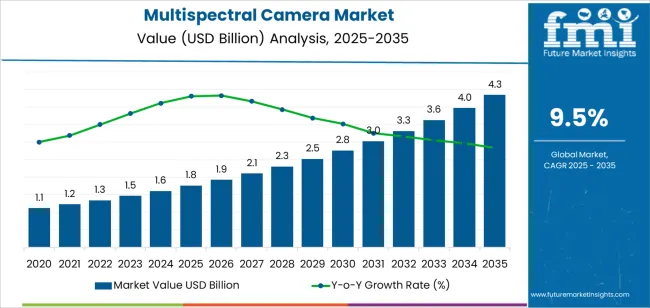
| Metric | Value |
|---|---|
| Multispectral Camera Market Estimated Value in (2025 E) | USD 1.8 billion |
| Multispectral Camera Market Forecast Value in (2035 F) | USD 4.3 billion |
| Forecast CAGR (2025 to 2035) | 9.5% |
The market is segmented by Cooling Technology, Image Spectrum, and Application and region. By Cooling Technology, the market is divided into Uncooled and Cooled. In terms of Image Spectrum, the market is classified into Long Wave Infrared, Visible light, Near Infrared, Short Wave Infrared, and Mid Wave Infrared. Based on Application, the market is segmented into Defence, Commercial, Survey Mapping, Environmental monitoring, and Life Science and Medical Diagnostics. Regionally, the market is classified into North America, Latin America, Western Europe, Eastern Europe, Balkan & Baltic Countries, Russia & Belarus, Central Asia, East Asia, South Asia & Pacific, and the Middle East & Africa.
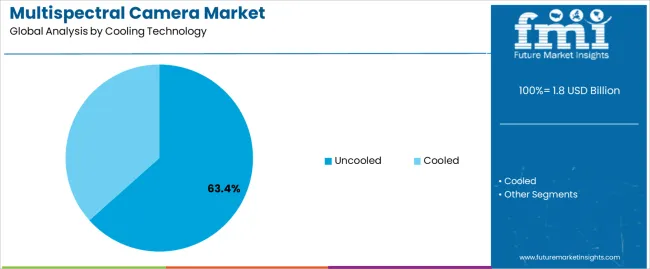
The uncooled segment, accounting for 63.40% of the cooling technology category, dominates the market due to its cost efficiency, compact design, and suitability for a wide range of commercial and industrial applications. These systems are preferred for their lower maintenance requirements and energy-efficient operation.
Advancements in microbolometer technology have enhanced sensitivity and thermal resolution, narrowing the performance gap with cooled counterparts. Uncooled multispectral cameras are increasingly integrated into drones, surveillance devices, and inspection tools, enabling wide adoption across multiple industries.
The absence of cryogenic cooling components has reduced system weight and complexity, making these cameras more accessible and easier to deploy Continuous improvements in sensor calibration and image-processing algorithms are expected to sustain the segment’s dominance and expand its applicability in both defense and civilian imaging operations.
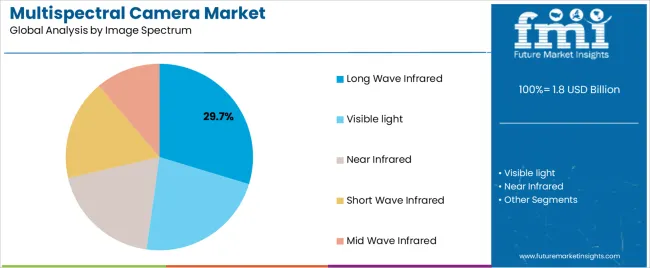
The long wave infrared segment, representing 29.70% of the image spectrum category, has gained prominence due to its ability to capture precise thermal information under low-light and adverse environmental conditions. Its applications in defense, security, and industrial diagnostics have reinforced consistent market demand.
The segment’s growth is being supported by technological innovations in detector materials and thermal calibration techniques, which have enhanced performance reliability. Integration with AI-driven analytics has improved image interpretation accuracy, enabling predictive monitoring and maintenance across industrial setups.
Long wave infrared imaging is increasingly employed in surveillance, target acquisition, and temperature mapping, where precision and stability are critical As production costs decline and sensor performance improves, the segment is projected to maintain a stable growth trajectory and continue driving advancements in multispectral imaging solutions.
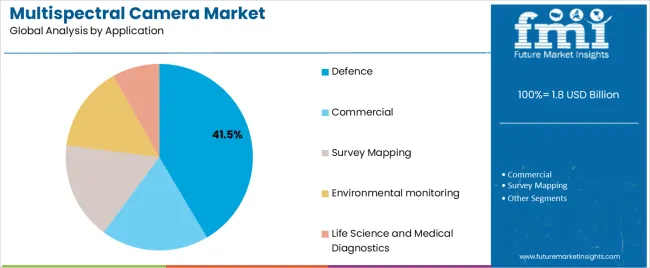
The defence segment, holding 41.50% of the application category, remains the leading contributor due to sustained global investments in surveillance, reconnaissance, and target acquisition systems. Demand is being reinforced by modernization of military equipment, border security initiatives, and increasing deployment of unmanned aerial vehicles equipped with multispectral imaging capabilities.
The use of these cameras for enhanced situational awareness, threat detection, and battlefield assessment has established strong market traction. Defense agencies are prioritizing the integration of compact, high-sensitivity imaging systems capable of operating under extreme conditions.
Strategic collaborations between defense contractors and imaging technology firms have accelerated innovation, resulting in ruggedized designs and improved operational endurance As global defense budgets continue to rise and geostrategic tensions persist, the defence application segment is expected to retain its leadership and drive sustained growth within the multispectral camera market.
| Attributes | Details |
|---|---|
| Top Cooling Technology | Cooled |
| CAGR from 2025 to 2035 | 13.7% |
| Attributes | Details |
|---|---|
| Top Image Spectrum | Visible Light |
| CAGR from 2025 to 2035 | 13.5% |
| Countries | CAGR through 2035 |
|---|---|
| United States | 9.8% |
| United Kingdom | 10.8% |
| China | 9.9% |
| Japan | 11.2% |
| South Korea | 10.9% |
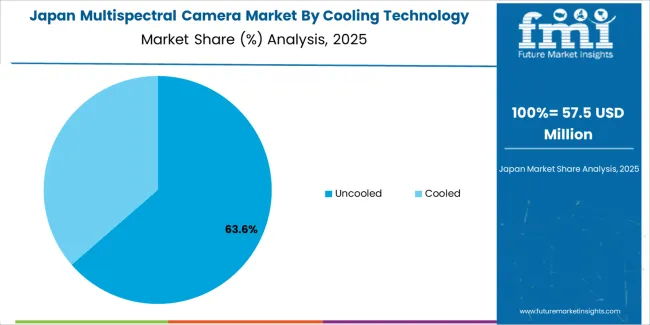
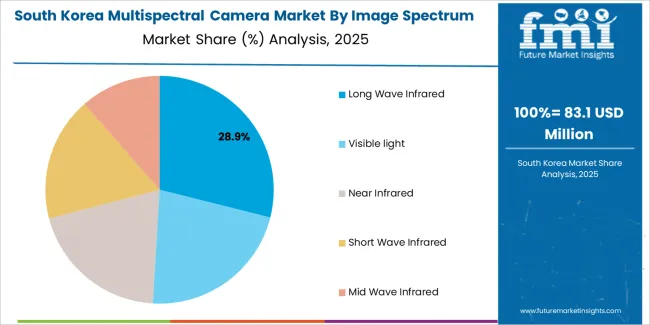
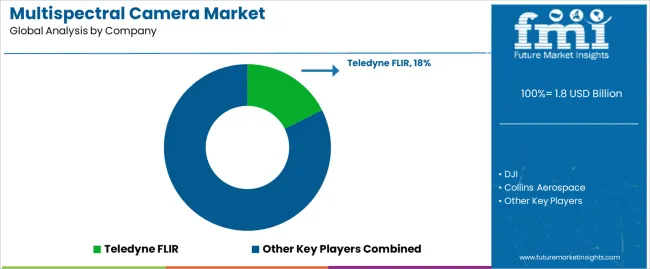
The market is highly competitive, with numerous players vying for market share. The market is driven by demand from various sectors, including agriculture, healthcare, and defense. Multispectral cameras are used extensively in precision agriculture to assess crop health, detect diseases, and optimize crop yields.
The healthcare sector uses multispectral cameras for imaging and diagnosis, while the defense sector uses them for surveillance and reconnaissance. The market is characterized by constant innovation, with players investing heavily in R&D to develop new products and technologies that offer superior performance and functionality.
Several players are also focusing on expanding their geographical presence by entering into strategic partnerships and collaborations with regional players.
Recent Developments in the Multispectral Camera Market
In 2025, an innovative multi-spectral camera named Hawk Indigo was recently unveiled by Raptor Photonics. The camera is designed to be durable and features a cutting-edge 2/3" CMOS sensor. This highly advanced sensor is capable of delivering exceptional UV sensitivity and boasts an impressive quantum efficiency (QE) of 36% at 250 nm.
The global multispectral camera market is estimated to be valued at USD 1.8 billion in 2025.
The market size for the multispectral camera market is projected to reach USD 4.3 billion by 2035.
The multispectral camera market is expected to grow at a 9.5% CAGR between 2025 and 2035.
The key product types in multispectral camera market are uncooled and cooled.
In terms of image spectrum, long wave infrared segment to command 29.7% share in the multispectral camera market in 2025.






Our Research Products

The "Full Research Suite" delivers actionable market intel, deep dives on markets or technologies, so clients act faster, cut risk, and unlock growth.

The Leaderboard benchmarks and ranks top vendors, classifying them as Established Leaders, Leading Challengers, or Disruptors & Challengers.

Locates where complements amplify value and substitutes erode it, forecasting net impact by horizon

We deliver granular, decision-grade intel: market sizing, 5-year forecasts, pricing, adoption, usage, revenue, and operational KPIs—plus competitor tracking, regulation, and value chains—across 60 countries broadly.

Spot the shifts before they hit your P&L. We track inflection points, adoption curves, pricing moves, and ecosystem plays to show where demand is heading, why it is changing, and what to do next across high-growth markets and disruptive tech

Real-time reads of user behavior. We track shifting priorities, perceptions of today’s and next-gen services, and provider experience, then pace how fast tech moves from trial to adoption, blending buyer, consumer, and channel inputs with social signals (#WhySwitch, #UX).

Partner with our analyst team to build a custom report designed around your business priorities. From analysing market trends to assessing competitors or crafting bespoke datasets, we tailor insights to your needs.
Supplier Intelligence
Discovery & Profiling
Capacity & Footprint
Performance & Risk
Compliance & Governance
Commercial Readiness
Who Supplies Whom
Scorecards & Shortlists
Playbooks & Docs
Category Intelligence
Definition & Scope
Demand & Use Cases
Cost Drivers
Market Structure
Supply Chain Map
Trade & Policy
Operating Norms
Deliverables
Buyer Intelligence
Account Basics
Spend & Scope
Procurement Model
Vendor Requirements
Terms & Policies
Entry Strategy
Pain Points & Triggers
Outputs
Pricing Analysis
Benchmarks
Trends
Should-Cost
Indexation
Landed Cost
Commercial Terms
Deliverables
Brand Analysis
Positioning & Value Prop
Share & Presence
Customer Evidence
Go-to-Market
Digital & Reputation
Compliance & Trust
KPIs & Gaps
Outputs
Full Research Suite comprises of:
Market outlook & trends analysis
Interviews & case studies
Strategic recommendations
Vendor profiles & capabilities analysis
5-year forecasts
8 regions and 60+ country-level data splits
Market segment data splits
12 months of continuous data updates
DELIVERED AS:
PDF EXCEL ONLINE
Camera Accessories Market Size and Share Forecast Outlook 2025 to 2035
Camera Lens Market Size and Share Forecast Outlook 2025 to 2035
Camera Module Market Size and Share Forecast Outlook 2025 to 2035
Camera Technology Market Analysis – Trends & Forecast 2025 to 2035
Camera Case Market Trends & Industry Growth Forecast 2024-2034
IP Camera Market Trends – Growth, Demand & Forecast 2025 to 2035
3D Camera Market Growth – Trends & Forecast 2025 to 2035
TDI Camera Market Growth - Trends & Forecast 2025 to 2035
Intracameral Antibiotics Market Analysis - Size, Share, and Forecast Outlook 2025 to 2035
CMOS Camera Market Size and Share Forecast Outlook 2025 to 2035
GigE Camera Market Size and Share Forecast Outlook 2025 to 2035
CCTV Camera Market Demand & Sustainability Trends 2025-2035
Smart Camera Market Analysis – Size, Share & Forecast 2025 to 2035
Drain Camera Market
InGaAs Cameras Market by Technology, Scanning Type, Industry & Region Forecast till 2035
Action Camera Market
Mobile Camera Module Market
Network Cameras and Video Analytics Market Analysis – Trends & Forecast 2025 to 2035
Security Cameras (IR Illuminator) Market Size and Share Forecast Outlook 2025 to 2035
Aircraft Cameras Market Size and Share Forecast Outlook 2025 to 2035

Thank you!
You will receive an email from our Business Development Manager. Please be sure to check your SPAM/JUNK folder too.
Chat With
MaRIA